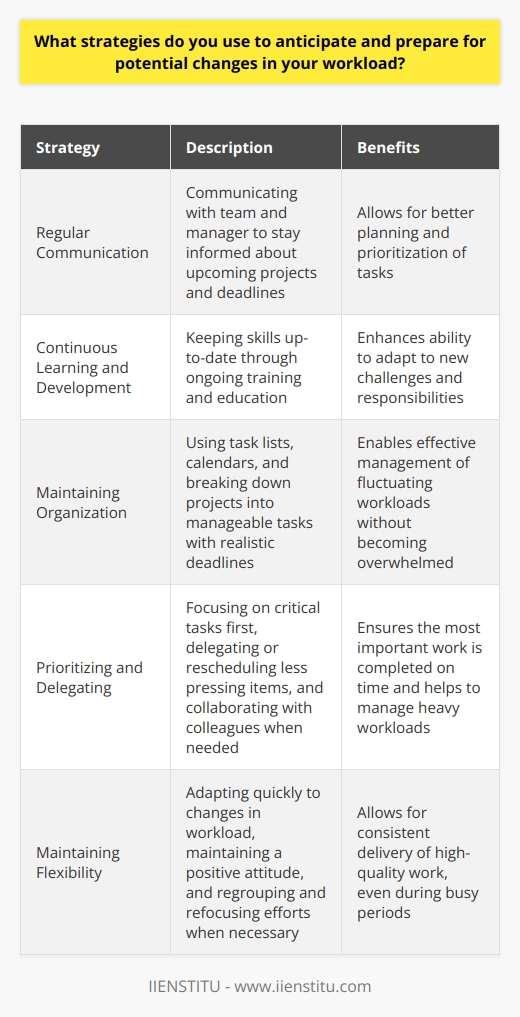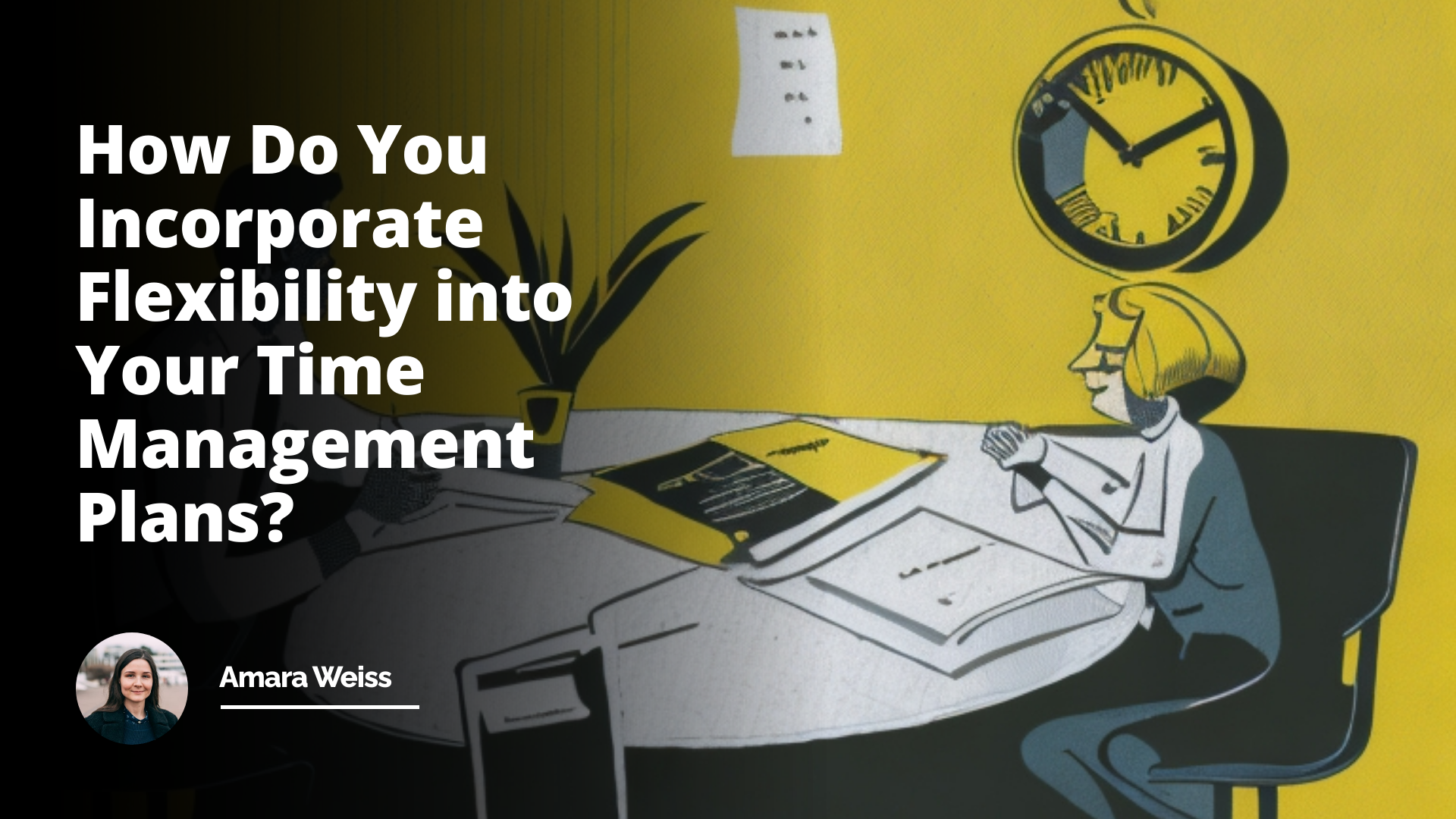
In today's fast-paced, ever-changing work environment, flexibility becomes a highly sought-after trait. Hence, interviewers often pose the question, "How do you incorporate flexibility into your Time Management Plans?"
Related Course: Time Management Free Online Course
It assesses your ability to adapt and manage change and offers a glance into your problem-solving and organizational skills.
The Purpose of the Question: How Do You Incorporate Flexibility into Your Time Management Plans?
When employers ask, "How do you incorporate flexibility into your Time Management plans?" they are keen on knowing whether you can fluidly respond to unpredictable events without diminishing productivity and efficiency.
They are interested to learn about your strategies for fitting unplanned tasks or activities into your schedule without upsetting the overall workflow.
At What Interview Level is it Asked?
This question is not level-specific. It can come up at any stage of the interview process - be it an entry-level role or a top-tier executive position.
Adapting To Logistics İndustry Changes İnterview Question Strategies
How Do You Handle Time Management İn Collaborative Projects İnterview Question
It is particularly integral for roles that demand project management, scheduling, or numerous assignments that are highly susceptible to change.
Interview Question: How do you plan to handle conflicts with supply chain suppliers?
Interview Question: How Do You Handle Time Management Interruptions?
Interview Question: What Relaxes You During Stressful Times?
What Kind of Answer is Expected from the Candidate?
Your response to the question, "How do you incorporate flexibility into your time management plans?" should exhibit your tactical time management skills as well as your ability to remain poised under pressure. Interviewers look for candidates that can present practical examples from their past experiences illustrating their flexible approach to time management.
Possible Answers to Consider
Successful answers to the question, "How do you incorporate flexibility into your time management plans?", often revolve around concrete examples and action plans. It may sound like:
"In my previous role, I always reserved 20-30% of my day for unplanned tasks or emergencies. By doing this, I was able to accommodate unforeseen activities without altering the day's schedule. I found that this approach allowed a smooth and less-stressful working experience."
Or you can invoke a scenario:
"When overseeing a project, I ensure there is built-in flexibility by scheduling in buffer times between tasks. For example, in the past, I managed an unpredictable project where we highly relied on external suppliers. By incorporating additional time into our timeframe, we were able to accommodate inevitable last-minute adjustments."
When outlining your response, consider highlighting your proactive mindset, problem-solving aptitude, and readiness for change.
Concluding Thoughts
Mastering the art of being flexible with your time management plans requires sophisticated skills and strategic insights. In answering this question, showcase your talent in adeptly weaving unpredictability into your schedules without compromising on effectiveness and productivity.
Remember, "How do you incorporate flexibility into your time management plans?" is an opportunity to represent your resilience, practical wisdom, and ability to thrive in a dynamic work environment. So, the next time you face this question, present examples that show your adaptability shine!
Remember: no one plans to fail; they just fail to plan—and failing to plan for flexibility in a world of continuous change means planning to be left behind. Be prepared, stay nimble, and lead the change.
Methods to Incorporate Flexibility into Time Management
The table that provides an overview of flexibility in time management
Impact of Flexibility in Time Management on Productivity
Similar interview questions:
What methods do you use to include flexibility in your time management strategies?
Can you explain your process of integrating flexibility into your time management plan?
In which ways do you allow for adaptability within your Time Management Techniques?
Could you describe how you build in flexibility when managing your schedule?
What steps do you take to ensure your time management plan is flexible?
How do you balance flexibility with structure in your time management tactics?
What is your strategy for ensuring adaptability in your time management plans?
How do you approach incorporating flexibility in your time management habits?
Could you provide an example of how you insert flexibility into your time management?
How do you promote flexibility while managing your time effectively?
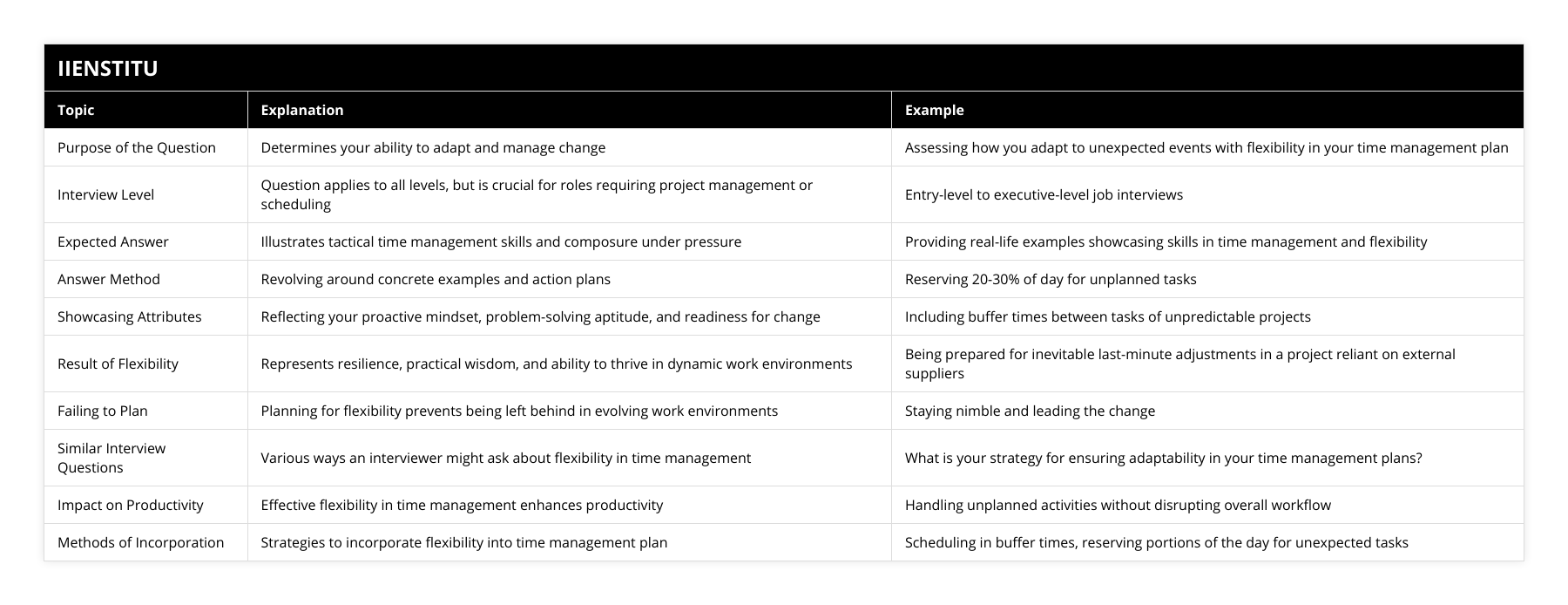
Frequently Asked Questions
How do you prioritize tasks when your schedule is constantly changing?
When faced with a constantly changing schedule, I prioritize tasks based on their urgency and importance. I assess each task's deadline and potential impact on the company's goals.
Communicate with Team Members
I regularly communicate with my team members to understand their priorities and how my tasks align with them. This helps me adjust my schedule accordingly and ensures that I'm working on the most critical tasks.
Use Time Management Tools
I utilize time management tools like digital calendars and task lists to keep track of my responsibilities. These tools help me stay organized and focused, even when my schedule is in flux.
Be Flexible and Adaptable
I understand that priorities can shift unexpectedly, so I remain flexible and adaptable. If a high-priority task arises, I'm prepared to adjust my schedule and reprioritize my work.
Continuously Reassess Priorities
Throughout the day, I reassess my priorities to ensure that I'm always working on the most important tasks. If a task becomes less urgent or important, I'm comfortable delaying or delegating it to focus on higher-priority work.
In my previous role, I once had to juggle multiple projects with shifting deadlines. By communicating with my team, using time management tools, and remaining flexible, I was able to successfully prioritize my tasks and deliver high-quality work on time.
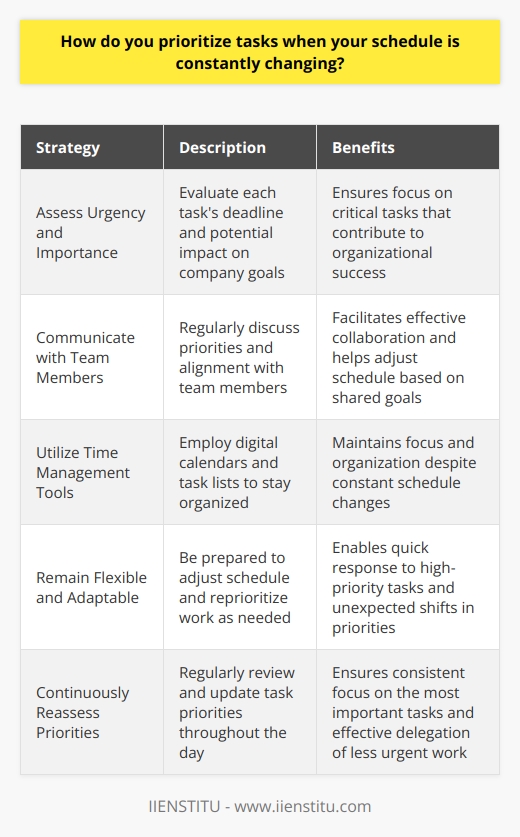
What strategies do you use to adapt to unexpected changes in your work day?
I adapt to unexpected changes in my work day by staying flexible and prioritizing tasks effectively. I understand that plans can change at a moment's notice, so I'm always ready to adjust my schedule and focus on the most critical tasks first.
Communicate with the Team
When unexpected changes occur, I quickly communicate with my team to understand how these changes impact our goals. By staying in close contact with my colleagues, we can work together to find solutions and keep projects moving forward smoothly.
Example: Last-Minute Client Request
Just last week, a client called with an urgent request that required me to shift my priorities for the day. I immediately notified my team, and we devised a plan to divide and conquer the necessary tasks. By collaborating effectively, we were able to meet the client's needs while still making progress on our other projects.
Maintain a Positive Attitude
I believe that maintaining a positive attitude is crucial when dealing with unexpected changes. Instead of getting frustrated or overwhelmed, I try to view these situations as opportunities to showcase my adaptability and problem-solving skills.
Example: System Outage
A few months ago, our company experienced a system outage that temporarily halted our work. Rather than sitting idle, I took the initiative to brainstorm alternative ways to keep things moving. I suggested that we use the downtime to catch up on some much-needed training and team-building activities. By staying positive and proactive, we were able to make the most of a challenging situation.
At the end of the day, I believe that the key to adapting to unexpected changes is to remain calm, communicate effectively, and focus on finding solutions. By staying flexible and maintaining a positive outlook, I'm able to navigate even the most challenging workdays successfully.
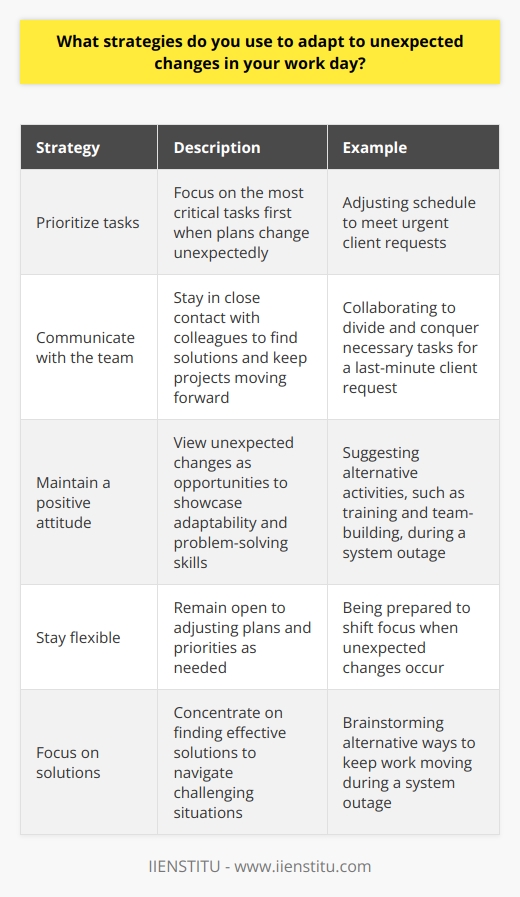
How do you ensure that you meet deadlines when faced with last-minute requests?
When faced with last-minute requests, I prioritize tasks based on urgency and importance. I communicate openly with my team and managers about my workload and any potential challenges in meeting tight deadlines.
Strategies for Meeting Last-Minute Deadlines
Break Down the Task
I break down the request into smaller, manageable steps. This helps me focus on one thing at a time and ensures I don't miss any crucial aspects of the task.
Set Mini-Deadlines
I set mini-deadlines for each step of the task. This keeps me on track and allows me to monitor my progress closely. If I fall behind, I can quickly adjust my approach to catch up.
Collaborate with Colleagues
If the request is complex or requires input from others, I reach out to my colleagues for help. Collaborating with team members can speed up the process and bring fresh perspectives to the task.
Manage Expectations
I communicate regularly with the person who made the request, providing updates on my progress and any obstacles I encounter. If I anticipate missing the deadline, I inform them as soon as possible and propose alternative solutions.
Personal Experience
In my previous role, I once received a last-minute request to prepare a presentation for a client meeting scheduled for the next morning. I stayed late at the office, focusing on the most essential information and creating visually appealing slides. Although it was a stressful experience, I managed to deliver a successful presentation that impressed the client and my manager.
Meeting last-minute deadlines can be challenging, but with the right strategies and mindset, it's possible to deliver quality work under pressure. I believe in staying calm, communicating effectively, and breaking down tasks into manageable steps to ensure success.

Describe a time when you had to adjust your plans due to unforeseen circumstances.
I once had to adjust my plans for a crucial product launch due to a supplier's unexpected delay. It was a challenging situation that required quick thinking and adaptability.
Assessing the Situation
When I received the news, I immediately gathered my team to assess the impact on our timeline. We brainstormed potential solutions and identified the most feasible options.
Communicating with Stakeholders
I promptly informed our stakeholders about the situation and presented our proposed solutions. Transparency and clear communication were key in maintaining their trust and support.
Implementing Plan B
We decided to proceed with an alternative supplier who could meet our deadlines, albeit at a higher cost. It wasn't ideal, but it was necessary to keep the project on track.
Adjusting Marketing Strategies
I worked closely with our marketing team to adjust our campaign to align with the new launch date. We focused on building anticipation and creating buzz around the upcoming release.
Learning from the Experience
This experience taught me the importance of having contingency plans and being prepared for the unexpected. It also highlighted the value of a supportive and adaptable team.
In the end, we successfully launched the product, and it was well-received by our customers. I grew as a leader and learned to embrace challenges as opportunities for growth.
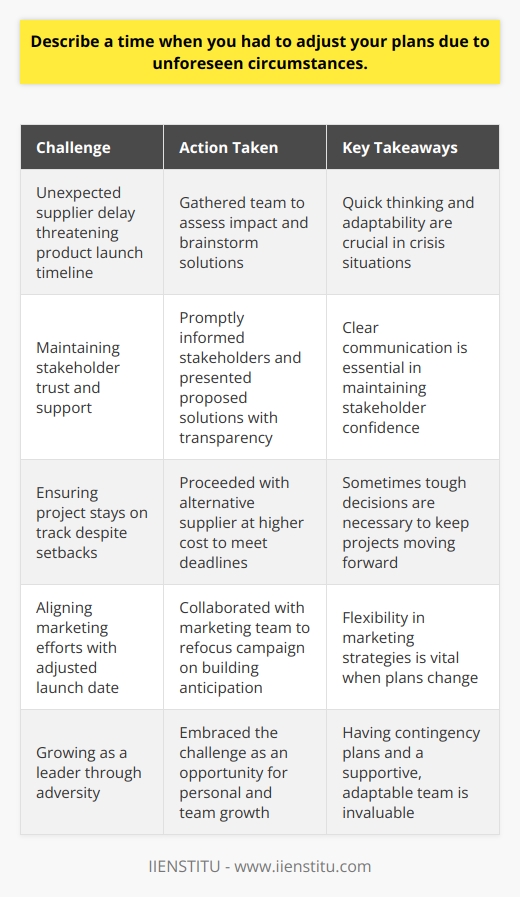
How do you handle interruptions while working on important tasks?
When it comes to handling interruptions while working on important tasks, I have a few strategies that help me stay focused and productive.
Prioritize and Communicate
First, I assess the urgency and importance of the interruption. If it's something that can wait, I politely let the person know that I'm in the middle of an important task and will get back to them as soon as possible. If it's urgent, I quickly address it and then return to my work.
Use Technology to Your Advantage
I also leverage technology to minimize distractions. I mute notifications on my phone and computer when I need to concentrate. Apps like Freedom and RescueTime help me block distracting websites and track my productivity.
Take Breaks and Recharge
When interruptions are frequent, I find it helpful to take short breaks to recharge. A quick walk around the office or a few minutes of deep breathing can do wonders for my focus and energy levels.
Stay Organized and Flexible
Ultimately, the key is to stay organized and be flexible. I keep a detailed to-do list and prioritize my tasks based on importance and deadlines. If an interruption throws me off course, I adjust my plan and keep moving forward.
By communicating effectively, using technology wisely, taking breaks when needed, and staying organized, I'm able to handle interruptions while still making progress on my most important work.
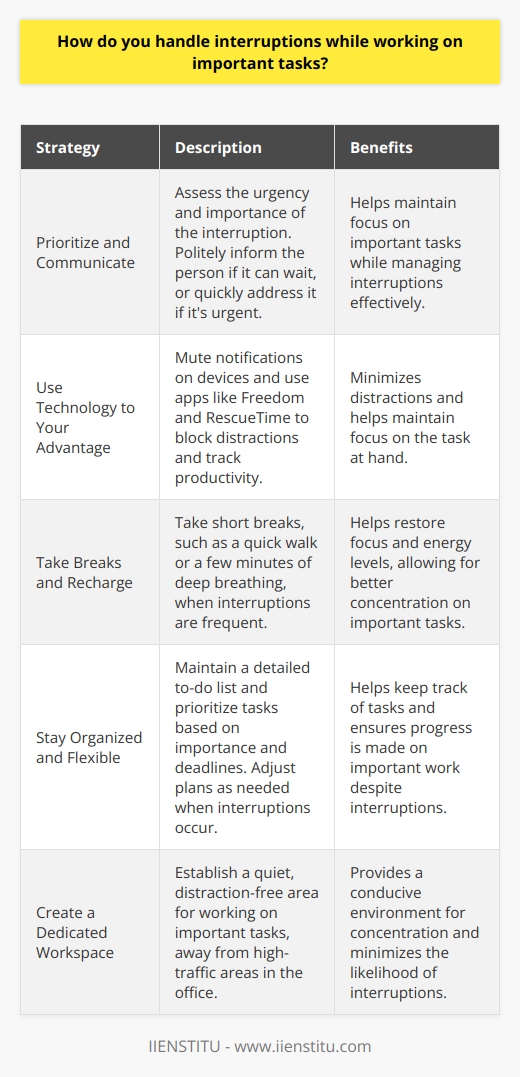
What techniques do you use to stay focused when your workload is unpredictable?
When faced with an unpredictable workload, I rely on several techniques to stay focused and productive.
Prioritizing Tasks
I start by prioritizing my tasks based on urgency and importance. This helps me tackle the most critical items first. I use a simple system of ranking tasks as high, medium, or low priority to stay organized.
Breaking Down Projects
For larger projects, I break them down into smaller, manageable steps. This makes the work feel less overwhelming. I set mini-deadlines for each step to keep myself on track and motivated.
Timeboxing Technique
I often use the timeboxing technique, where I allocate a fixed amount of time for each task. This creates a sense of urgency and helps me stay focused. I set a timer and work diligently until it goes off.
Minimizing Distractions
To maintain focus, I actively minimize distractions. I silence notifications on my phone and computer. I also use noise-canceling headphones when working in busy environments to block out background noise.
Taking Breaks
Taking regular breaks is crucial for maintaining focus, especially during busy periods. I step away from my desk every hour or so to stretch, walk around, or do a quick meditation. This helps me recharge and return to work with renewed energy.
By using these techniques, I'm able to stay focused and adapt to unpredictable workloads. It's all about finding what works best for you and sticking to it.
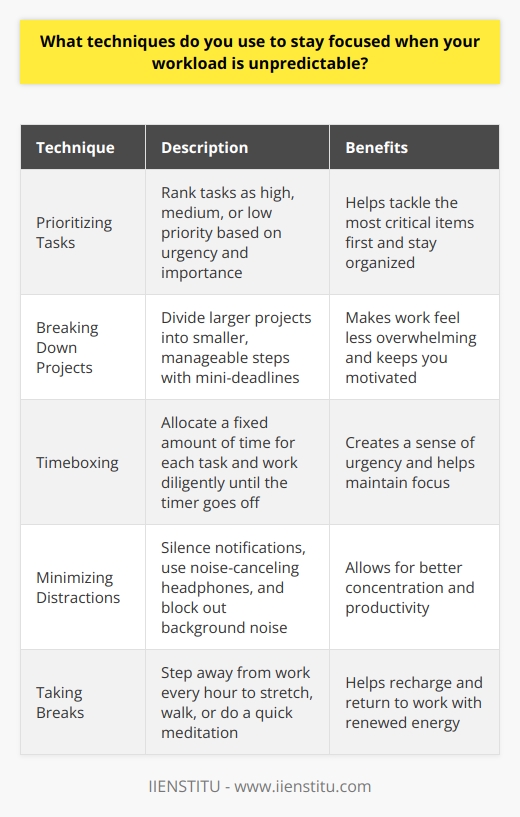
How do you communicate changes in your schedule to your team members or supervisor?
I believe in proactive communication when it comes to changes in my schedule. I always inform my team members and supervisor as soon as possible, typically via email or in-person conversation. This allows everyone to adjust their own schedules accordingly and minimizes disruptions to our workflow.
Providing Advance Notice
Whenever feasible, I try to give advance notice of any upcoming changes to my availability. Whether it's a planned vacation, a doctor's appointment, or a family commitment, I make sure to communicate these events well ahead of time. This gives my colleagues ample opportunity to plan around my absence and ensures that important tasks can be delegated or rescheduled as needed.
Maintaining Open Lines of Communication
I believe in maintaining open lines of communication with my team members and supervisor. If an unexpected situation arises that affects my schedule, I reach out immediately to discuss the issue and explore potential solutions. By keeping everyone in the loop, we can work together to find the best way forward and ensure that our projects stay on track.
Being Flexible and Adaptable
I understand that schedules can change unexpectedly, and I'm always willing to be flexible and adaptable when needed. If a colleague needs to shift their schedule or if an urgent task requires me to adjust my own plans, I'm open to finding creative solutions that work for everyone involved. By being responsive and accommodating, I aim to foster a collaborative and supportive work environment.
At the end of the day, my goal is to ensure that any changes in my schedule are communicated clearly, promptly, and professionally. By keeping my team members and supervisor informed and working together to find solutions, I believe we can navigate any challenges that come our way and achieve our shared goals.
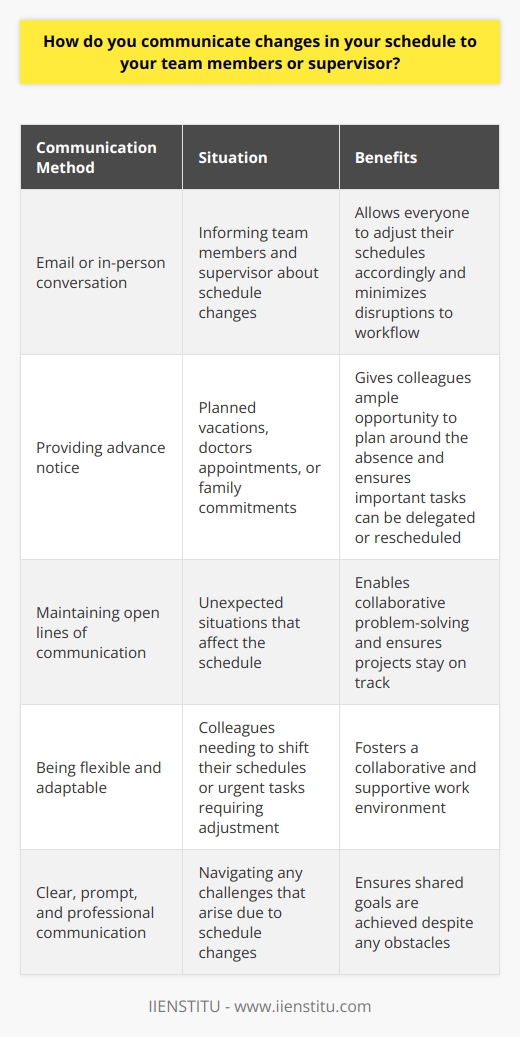
Describe a situation where you had to balance multiple priorities with limited time.
In my previous role as a project manager, I often faced situations where I had to juggle multiple priorities with tight deadlines. One particular instance that comes to mind was when I was leading a team of five to develop a new software feature for a client.
Assessing the Situation
The client suddenly moved up the deadline by two weeks, putting immense pressure on our team. At the same time, we were also working on another critical project that required our attention. I knew I had to act fast to ensure both projects were completed successfully.
Prioritizing and Delegating
I quickly called a team meeting to assess our priorities and redistribute tasks based on each member's strengths. We identified the most critical tasks for each project and allocated resources accordingly. I also reached out to our project sponsors to negotiate some flexibility on the less urgent deliverables.
Effective Communication and Collaboration
Throughout the process, I made sure to communicate regularly with my team and stakeholders. We had daily stand-up meetings to track progress, identify bottlenecks, and brainstorm solutions. I encouraged open communication and collaboration within the team, which helped us work more efficiently and support each other during this challenging time.
Successful Outcome
By prioritizing effectively, leveraging my team's strengths, and maintaining open lines of communication, we were able to deliver both projects successfully. The client was thrilled with the quality of our work and our ability to adapt to their changing needs.
This experience taught me the importance of staying calm under pressure, being proactive in communication, and trusting in my team's abilities. It was a challenging situation, but I'm proud of how we came together to achieve our goals.
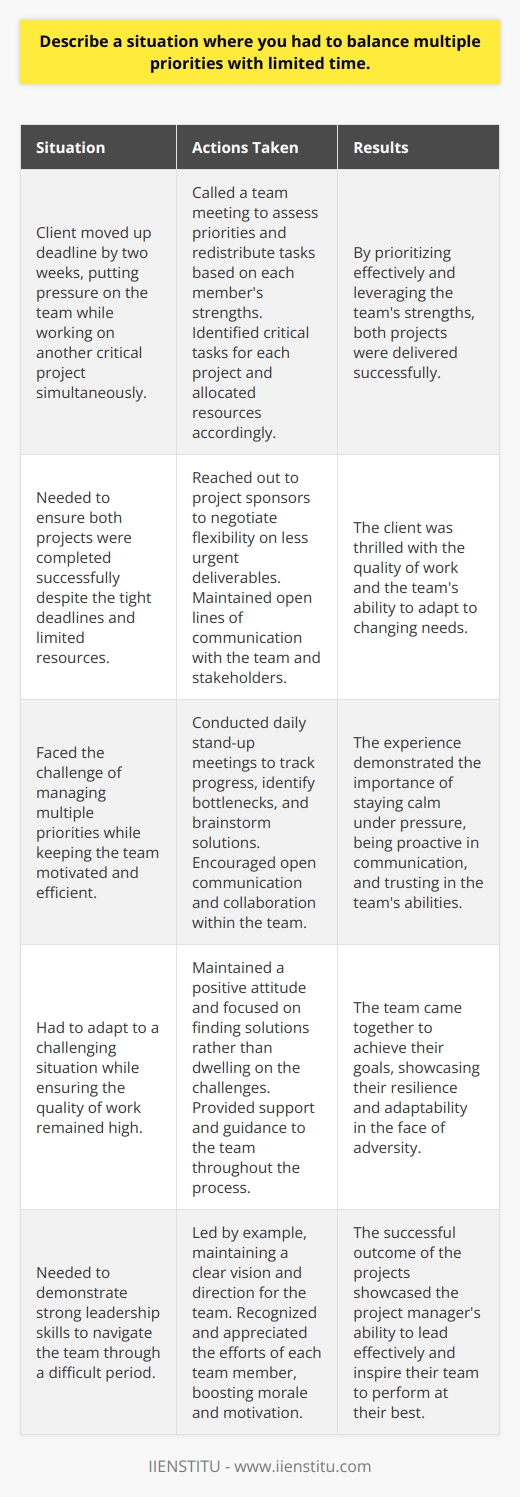
How do you determine which tasks can be postponed when unexpected issues arise?
When unexpected issues arise, I prioritize tasks based on their urgency and importance. I consider the potential consequences of postponing each task and make decisions accordingly.
Assessing Urgency and Importance
I quickly evaluate the urgency and importance of the unexpected issue and compare it to my existing tasks. If the new issue is more pressing or critical, I may need to postpone some of my current work.
Communicating with Stakeholders
If postponing a task will impact others, I communicate with them promptly. I explain the situation, provide a revised timeline, and work with them to minimize any inconvenience or disruption.
Prioritizing Based on Consequences
I assess the potential consequences of postponing each task. Tasks that have significant financial, legal, or safety implications generally take precedence over those with less severe outcomes.
Staying Flexible and Adaptable
I remain flexible and adaptable when unexpected issues arise. I understand that priorities can shift quickly, and I'm ready to adjust my plans as needed to ensure the most critical work gets done.
By carefully considering urgency, importance, and consequences, I can make informed decisions about which tasks can be postponed when the unexpected occurs. Regular communication and a willingness to adapt help me navigate challenging situations effectively.
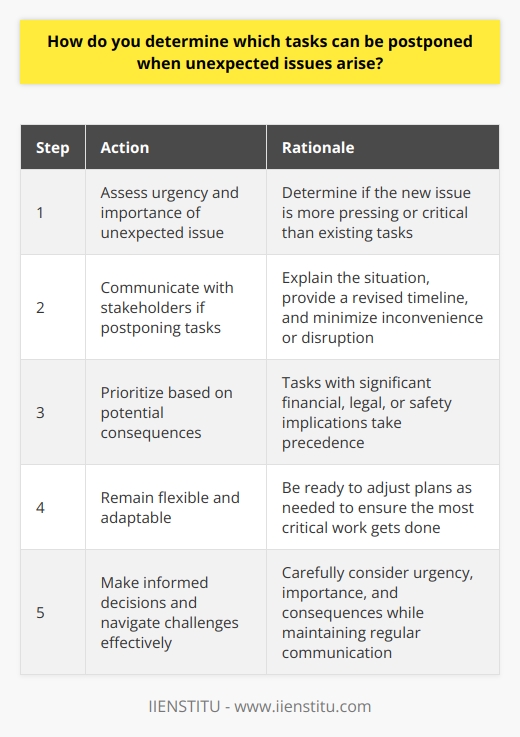
What methods do you use to quickly reassess and reorganize your to-do list?
As a professional, I understand the importance of staying organized and adapting to changing priorities. When it comes to quickly reassessing and reorganizing my to-do list, I rely on a few tried-and-true methods that help me stay on top of my tasks.
Prioritize based on urgency and importance
I start by evaluating each task based on its urgency and importance. I ask myself, "Which tasks have the most pressing deadlines?" and "Which tasks will have the greatest impact on my goals?" By answering these questions, I can quickly identify the items that need my immediate attention and those that can wait.
Use a visual system
I'm a visual learner, so I like to use color-coding and symbols to categorize my tasks. For example, I might use a red flag for urgent tasks, a yellow highlight for important but not urgent tasks, and a green checkmark for completed items. This helps me see at a glance what needs to be done and in what order.
Break down larger tasks
When I have a big project on my plate, I break it down into smaller, manageable steps. This makes it easier to see progress and stay motivated. I also build in buffer time for unexpected challenges or interruptions.
Regularly review and adjust
I set aside time each day and week to review my to-do list and make any necessary adjustments. This helps me stay flexible and responsive to changing priorities or new information. I also celebrate my accomplishments along the way, which keeps me energized and focused.
By using these methods consistently, I'm able to stay organized, productive, and adaptable no matter what challenges come my way.
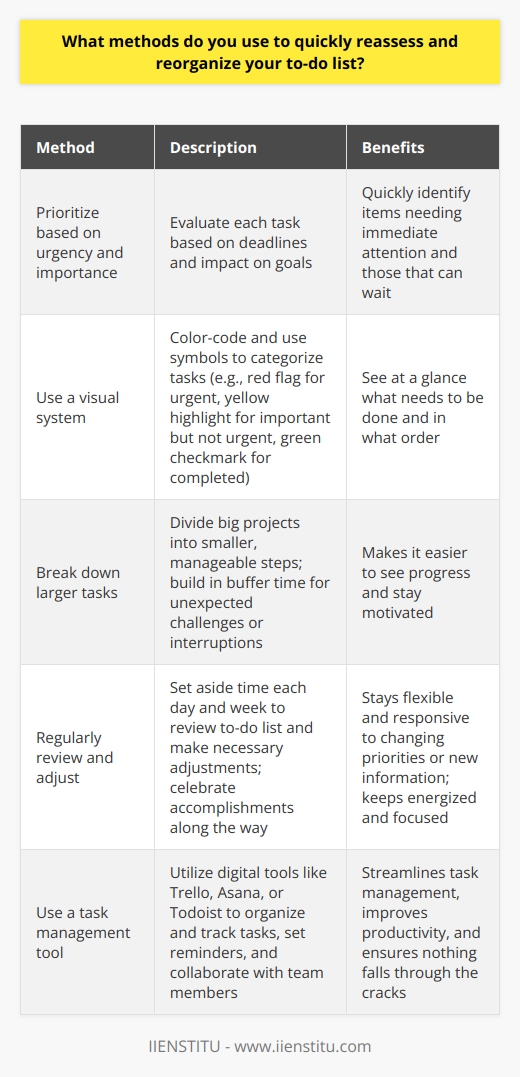
How do you maintain a healthy work-life balance when your work schedule is flexible?
Maintaining a healthy work-life balance with a flexible work schedule requires discipline, planning, and setting boundaries.
Set a Schedule and Stick to It
I create a daily schedule that includes work hours, breaks, and personal time. This helps me stay focused and productive during work hours while ensuring I have time for myself and my loved ones.
Prioritize Tasks and Manage Time Effectively
I prioritize my tasks based on importance and urgency. This allows me to tackle the most critical tasks first and manage my time more efficiently. I also use time-blocking techniques to dedicate specific hours to different activities, such as work, exercise, and hobbies.
Establish Boundaries and Communicate Them
I set clear boundaries between my work and personal life. I communicate my availability to colleagues and clients and make sure they understand when I am not available. This helps prevent work from spilling over into my personal time.
Take Breaks and Disconnect
I take regular breaks throughout the day to recharge and avoid burnout. I also make sure to disconnect from work-related devices and notifications during my personal time. This allows me to fully engage in activities outside of work and enjoy my downtime.
Practice Self-Care and Engage in Hobbies
I prioritize self-care activities, such as exercise, meditation, and spending time with loved ones. Engaging in hobbies and activities I enjoy helps me maintain a sense of balance and reduces stress. I also make sure to get enough sleep and eat a healthy diet to maintain my physical and mental well-being.
By setting a schedule, prioritizing tasks, establishing boundaries, taking breaks, and practicing self-care, I am able to maintain a healthy work-life balance despite having a flexible work schedule. It takes effort and discipline, but it is essential for my overall happiness and success.

Describe a time when you had to adapt to a new project or role on short notice.
I once had to adapt to a new project on short notice when a colleague unexpectedly left the company. It was a challenging situation, but I took it as an opportunity to grow and learn.
Assessing the Situation
The first thing I did was thoroughly review the project documentation and requirements. I met with the project manager and team to understand the current status and priorities. It was crucial to get up to speed quickly and identify any gaps in my knowledge.
Collaborating with the Team
I openly communicated with my team members and asked for their support and guidance. They were incredibly helpful in bringing me up to speed and answering my questions. We worked together closely to ensure a smooth transition and minimize any disruptions to the project timeline.
Adapting My Skills
Although the project involved some technologies I wasn't as familiar with, I was confident in my ability to learn and adapt. I spent extra time outside of work hours studying and practicing to improve my proficiency. It was challenging but also rewarding to expand my skill set.
Focusing on Results
Despite the initial learning curve, I remained focused on delivering quality work and meeting project milestones. I communicated regularly with stakeholders to manage expectations and provide updates on my progress. Through hard work and dedication, I was able to successfully contribute to the project and even suggest some improvements along the way.
Lessons Learned
This experience taught me the importance of being adaptable and proactive in the face of unexpected changes. I learned to quickly assess situations, collaborate with others, and take initiative to fill knowledge gaps. It also reinforced my belief in the power of effective communication and teamwork.
In the end, successfully adapting to this new project on short notice boosted my confidence and prepared me to tackle future challenges with a positive attitude.
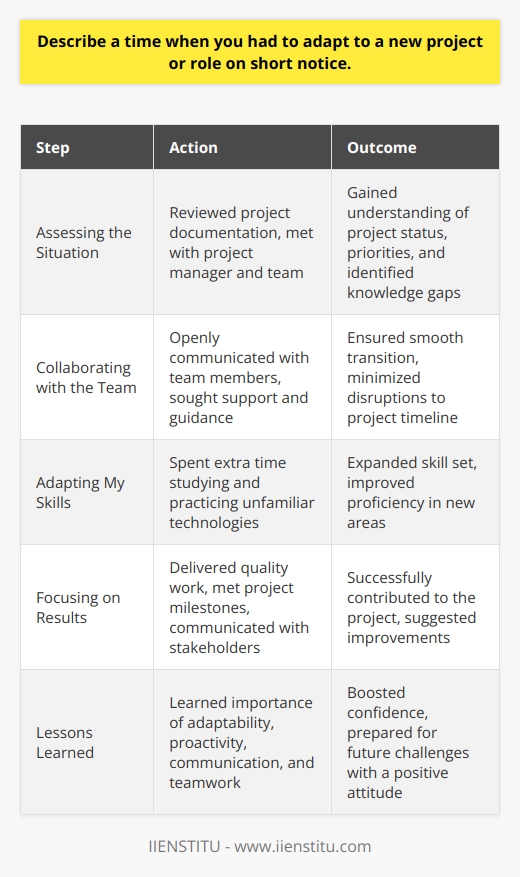
How do you ensure that you're making the most of your time when your workday is fluid?
To make the most of my time when my workday is fluid, I prioritize tasks based on importance and urgency. I create a to-do list and tackle the most critical items first. This helps me stay focused and productive, even when unexpected challenges arise.
Staying Organized and Flexible
I use a planner to keep track of my schedule and deadlines. However, I remain adaptable and willing to adjust my plans as needed. If an urgent matter comes up, I quickly reassess my priorities and shift my focus accordingly. Being organized yet flexible allows me to navigate fluid workdays effectively.
Communicating with My Team
Regular communication with my colleagues is essential when workdays are fluid. I provide updates on my progress and seek input when necessary. Collaborating with my team helps us coordinate our efforts and ensures that we're all working towards the same goals, even when our schedules are in flux.
Minimizing Distractions
To make the most of my time, I minimize distractions during my workday. I silence notifications on my phone and close unnecessary tabs on my computer. When I need to concentrate on a task, I find a quiet space to work and let my colleagues know that I'll be unavailable for a while.
Taking Breaks to Recharge
Even when my workday is fluid, I make sure to take short breaks to recharge. Stepping away from my desk for a few minutes helps me clear my mind and return to my tasks with renewed energy and focus. I've found that taking regular breaks actually boosts my productivity in the long run.
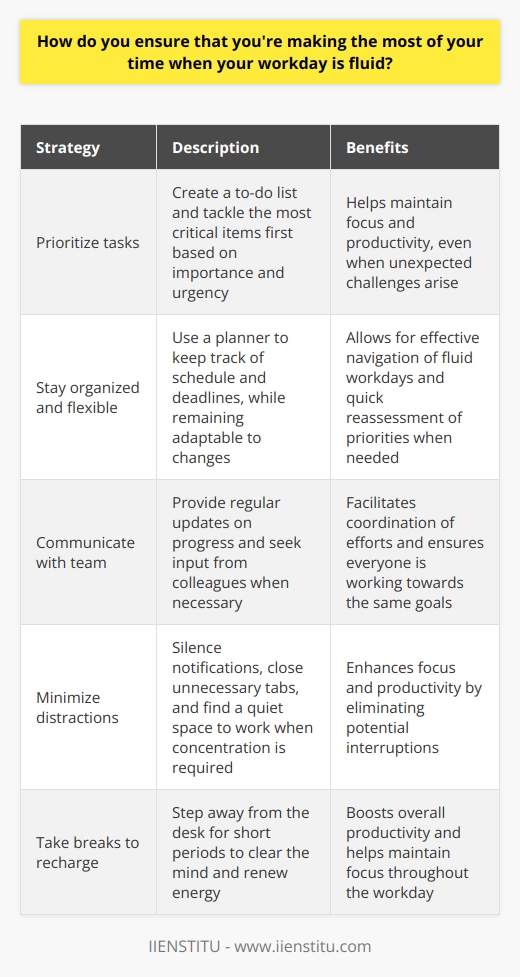
What strategies do you use to stay motivated when your plans are constantly changing?
Staying motivated when plans constantly change can be challenging, but I've found some effective strategies that work for me. First, I try to maintain a positive attitude and focus on the opportunities that change can bring. Rather than getting frustrated or discouraged, I look for ways to adapt and find new solutions.
Staying Flexible and Adaptable
One key strategy is to stay flexible and adaptable. I've learned that rigidity only leads to stress and disappointment when plans inevitably shift. By embracing a more fluid mindset, I'm better able to roll with the punches and adjust my approach as needed.
Setting Realistic Expectations
Another important aspect is setting realistic expectations. When I expect perfection or everything to go exactly as planned, I'm setting myself up for frustration. Instead, I try to anticipate that some things may change and build in contingencies and buffers.
Focusing on What I Can Control
I also find it helpful to focus on what I can control rather than worrying about factors outside my influence. By directing my energy towards the things I can impact, I feel more empowered and motivated to keep moving forward even when circumstances shift.
Celebrating Small Wins
Finally, I make a point to celebrate the small wins along the way. When plans change, it's easy to feel like I'm not making progress. But by acknowledging the steps I am taking and the milestones I do reach, I stay motivated and encouraged to keep going.
Ultimately, staying motivated in the face of constant change is about mindset and perspective. By staying positive, flexible, and focused on what I can control, I'm able to navigate shifts in plans and keep pursing my goals.
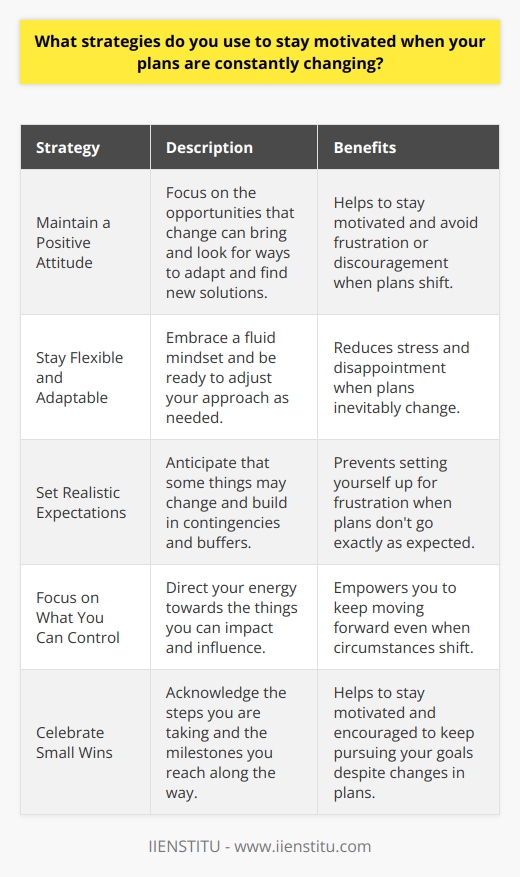
How do you handle the stress of managing a fluctuating workload?
When faced with a fluctuating workload, I focus on prioritization and time management. I start by identifying the most critical tasks and tackling them first. This helps me stay on top of deadlines and deliver high-quality work, even when the workload is heavy.
Staying Organized
I keep a detailed to-do list and calendar to ensure nothing falls through the cracks. Breaking larger projects into smaller, manageable steps allows me to maintain steady progress. Regular check-ins with my team and manager help me stay aligned with priorities and adjust my approach as needed.
Maintaining Work-Life Balance
When the workload is lighter, I use that time to get ahead on upcoming projects and develop new skills. I've found that learning opportunities, like attending workshops or taking online courses, help me stay motivated and engaged. Taking breaks throughout the day, whether it's a quick walk or chatting with colleagues, also helps me recharge and maintain a positive outlook.
Communicating Proactively
Open communication is key when managing a fluctuating workload. I keep my manager informed about my capacity and any potential roadblocks. If I'm feeling overwhelmed, I'm not afraid to ask for help or guidance. Collaborating with my team allows us to share the load and support each other during busy periods.
Embracing Flexibility
Ultimately, I've learned to embrace the ebb and flow of work. I see it as an opportunity to demonstrate my adaptability and resilience. By staying organized, communicating proactively, and maintaining a healthy work-life balance, I'm able to handle the stress of a fluctuating workload and deliver consistent results.
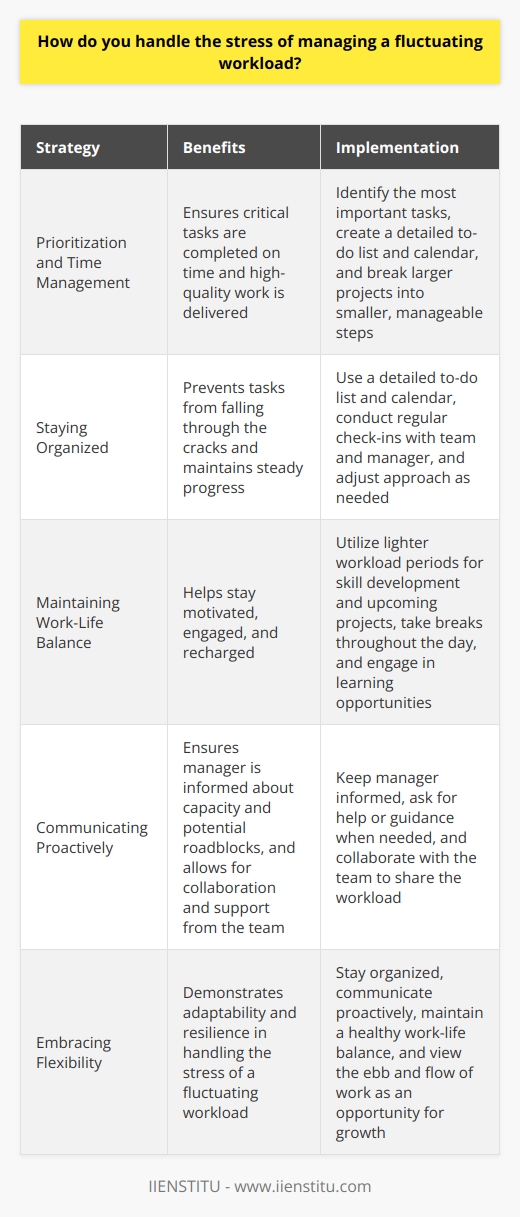
Describe a situation where you had to be creative in order to meet a deadline.
In my previous role as a graphic designer, I faced a challenging situation where a client requested a complete rebranding within an extremely tight timeframe. To meet the deadline, I had to think outside the box and come up with creative solutions.
Prioritizing Tasks and Collaborating with the Team
I quickly prioritized the most critical aspects of the rebranding, such as the logo and main visual elements. I then reached out to my colleagues and organized a brainstorming session to generate fresh ideas and divide tasks efficiently.
Leveraging Existing Resources and Inspiration
To save time, I decided to leverage some of our existing design assets and adapt them to fit the new brand identity. I also drew inspiration from the client's industry and target audience to create designs that would resonate with them.
Streamlining the Design Process with Technology
I utilized advanced design software and automation tools to streamline my workflow and create iterations quickly. This allowed me to present multiple options to the client and incorporate their feedback efficiently.
Going the Extra Mile to Ensure Timely Delivery
Despite the time crunch, I remained focused and dedicated extra hours to ensure the rebranding was completed on schedule. I communicated regularly with the client to keep them informed of the progress and made necessary adjustments based on their input.
In the end, my creative approach and determination paid off. The client was thrilled with the new brand identity, and we successfully launched it within the given deadline. This experience taught me the importance of adaptability, collaboration, and thinking creatively under pressure.
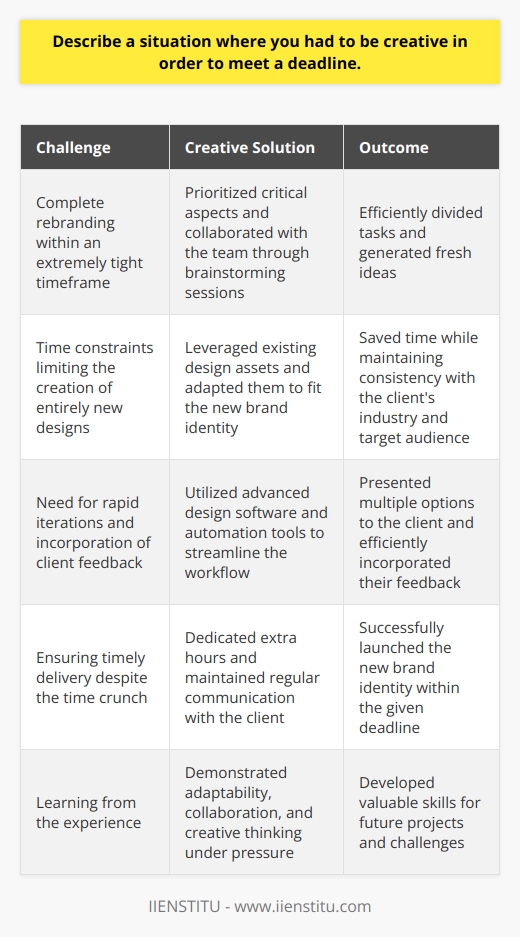
How do you prioritize self-care and prevent burnout when your schedule is unpredictable?
Prioritizing self-care is essential for maintaining physical and mental well-being, especially when facing an unpredictable schedule. I've learned that setting clear boundaries between work and personal time is crucial. This means dedicating specific hours to work and ensuring that I have time for rest and relaxation.
Establishing a Routine
Even with a busy schedule, I try to establish a consistent routine that includes regular exercise and healthy eating habits. I find that starting my day with a quick workout or meditation helps me feel energized and focused. I also make sure to take breaks throughout the day to stretch, hydrate, and refuel with nutritious snacks.
Prioritizing Self-Care Activities
I make a conscious effort to prioritize self-care activities that I enjoy, such as reading, practicing yoga, or spending time outdoors. These activities help me unwind and recharge, even if I only have a few minutes to spare. I also try to schedule regular social activities with friends and family to maintain a sense of connection and support.
Recognizing Signs of Burnout
It's important to recognize the signs of burnout, such as feeling consistently exhausted, irritable, or disengaged. When I notice these signs, I take a step back and reassess my priorities. I might need to delegate tasks, say no to non-essential commitments, or take a mental health day to rest and recharge.
Communicating with Colleagues and Supervisors
Finally, I believe in open communication with colleagues and supervisors about my workload and any challenges I'm facing. By being proactive and honest about my needs, I can work with my team to find solutions and ensure that I'm able to maintain a healthy work-life balance.
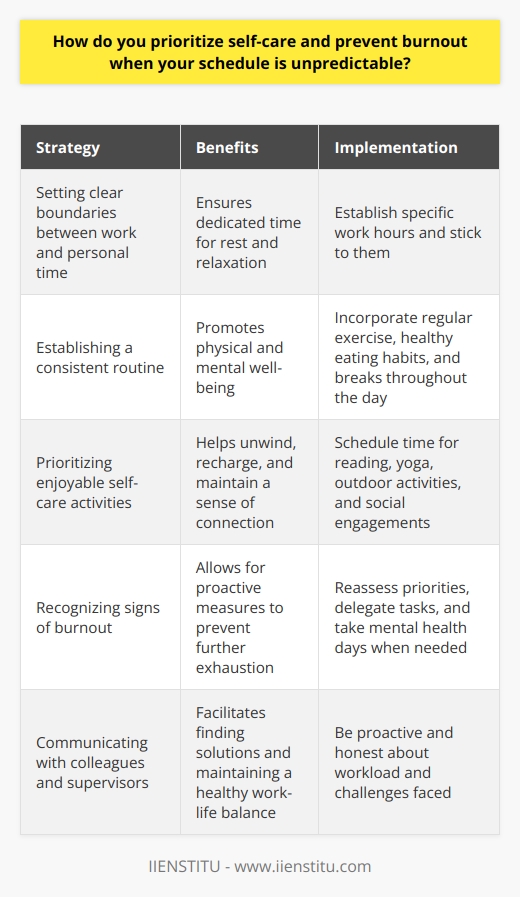
What tools or technologies do you use to help you stay organized and flexible?
As a professional, I rely on several tools and technologies to stay organized and flexible in my work. Firstly, I use a digital calendar to keep track of my appointments, deadlines, and meetings. This helps me manage my time effectively and ensures I don't miss any important events.
Project Management Software
For managing projects, I utilize a project management software like Trello or Asana. These tools allow me to create tasks, assign them to team members, set due dates, and track progress. They provide a clear overview of the project status and enable seamless collaboration with my colleagues.
Cloud Storage and Collaboration
Cloud storage platforms like Google Drive and Dropbox are essential for storing and accessing files from anywhere. They enable me to collaborate with others in real-time, making it easy to share documents, spreadsheets, and presentations. I can work on projects remotely and have access to the latest versions of files.
Communication Tools
Effective communication is crucial for staying organized and flexible. I use tools like Slack and Microsoft Teams for instant messaging, voice calls, and video conferencing. These platforms facilitate quick and efficient communication with my team, allowing us to discuss ideas, resolve issues, and stay connected even when working remotely.
Note-Taking Apps
To capture ideas and important information, I rely on note-taking apps like Evernote or OneNote. These apps allow me to create digital notes, organize them with tags and notebooks, and access them from any device. I can easily search for specific information whenever I need it.
Time Tracking and Productivity
To ensure I'm using my time effectively, I utilize time tracking tools like Toggl or RescueTime. These tools help me understand how much time I spend on different tasks and identify areas where I can improve my productivity. I can analyze my work patterns and make adjustments to optimize my efficiency.
By leveraging these tools and technologies, I'm able to stay organized, collaborate seamlessly with my team, and adapt to changing priorities. They enable me to be productive, efficient, and flexible in my work, ultimately contributing to the success of my projects and the organization as a whole.
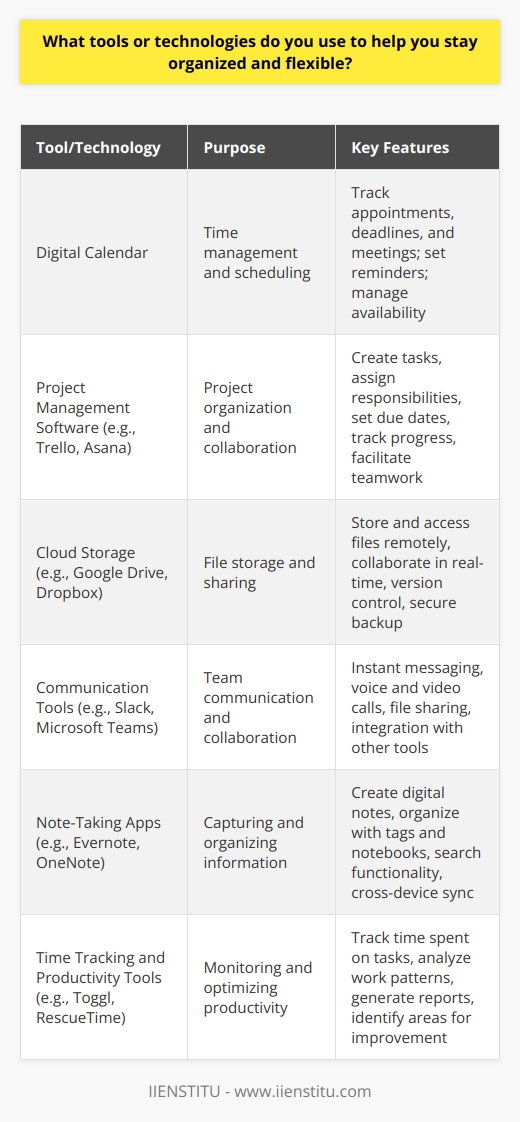
How do you ensure that you're communicating effectively with your team when plans change?
When plans change, effective communication with my team is crucial. I make sure to be proactive and transparent in my approach.
Proactive Communication
As soon as I become aware of a change in plans, I immediately notify my team. I don't wait for them to find out through other channels. By being proactive, I ensure everyone is on the same page and can adapt quickly.
Transparency is Key
I believe in being transparent about the reasons behind the change. I explain the context and the impact it may have on our work. This helps my team understand the bigger picture and fosters trust.
Adapting to Change
Once the team is informed, I collaborate with them to adjust our strategy. We discuss how to reallocate resources and prioritize tasks. I value their input and ideas in finding the best way forward.
Keeping Everyone Updated
Throughout the process, I keep the team updated on the progress. Regular check-ins, either through meetings or email, ensure no one feels left out. I make myself available to answer any questions or concerns they may have.
Learning from Experience
I remember a project where a last-minute client request forced us to change our plans. By communicating effectively and involving the team in the decision-making process, we were able to deliver the project successfully. It taught me the importance of adaptability and teamwork.
In summary, when plans change, I prioritize proactive communication, transparency, and collaboration with my team. By keeping everyone informed and engaged, we can navigate changes smoothly and achieve our goals together.

Describe a time when you had to adapt to a new work environment or culture.
When I started my previous job at a multinational company, I found myself in a completely new work environment. The company had a unique culture that emphasized collaboration, innovation, and diversity. At first, I felt overwhelmed by the fast-paced nature of the work and the complex network of teams and departments.
Embracing the Challenge
Instead of shying away from the challenge, I decided to embrace it. I took the initiative to introduce myself to my colleagues and learn about their roles and responsibilities. I attended company-wide meetings and training sessions to understand the organization's goals and values. By immersing myself in the new environment, I gradually became more comfortable and confident.
Adapting My Communication Style
One of the biggest adjustments I had to make was adapting my communication style. In my previous job, I was used to a more formal and hierarchical approach to communication. However, in this new environment, open and transparent communication was encouraged across all levels of the organization.
I learned to be more direct and concise in my communication, while also being open to feedback and ideas from others. I also made an effort to listen actively and ask questions to ensure that I fully understood my colleagues' perspectives.
Leveraging My Strengths
While adapting to the new environment, I also focused on leveraging my strengths and expertise. I looked for opportunities to contribute my skills and knowledge to projects and initiatives that aligned with the company's goals.
By demonstrating my value and willingness to learn, I quickly earned the trust and respect of my colleagues. I was able to build strong relationships and collaborate effectively with team members from diverse backgrounds and disciplines.
Lessons Learned
Adapting to a new work environment taught me valuable lessons about flexibility, communication, and collaboration. I learned that embracing change and stepping out of my comfort zone can lead to personal and professional growth. I also realized the importance of being open-minded and respectful of different perspectives and approaches.
Overall, this experience helped me become a more adaptable and resilient professional. It prepared me to thrive in dynamic and diverse work environments, and to navigate complex challenges with confidence and skill.
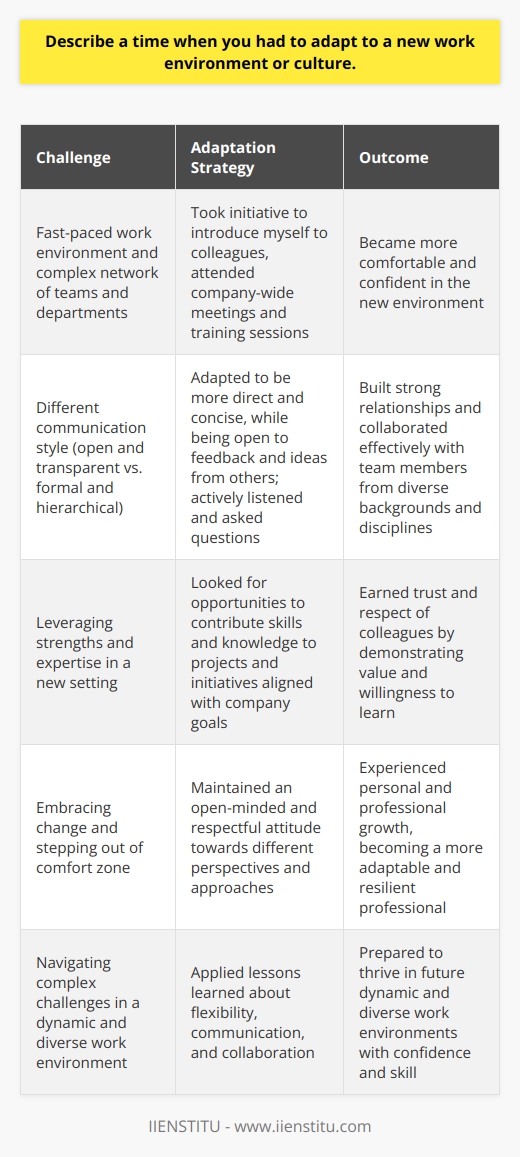
How do you handle the uncertainty of not knowing what tasks you'll be working on from day to day?
I embrace the uncertainty and variety that comes with not knowing my exact tasks from day to day. It keeps me on my toes and allows me to constantly learn and grow. I'm adaptable and quick to pick up new skills, so I can easily pivot to tackle whatever challenges come my way.
Thriving in Dynamic Environments
In my previous roles, I've thrived in fast-paced, ever-changing environments. I actually find it energizing to have my responsibilities evolve. It prevents boredom and stagnation. I'm always eager to dive into new projects and initiatives.
Proactive Communication
To navigate the uncertainty effectively, I believe in proactive communication. I touch base frequently with my manager and team to understand current priorities. Asking clarifying questions helps me stay aligned with goals, even as day-to-day tasks fluctuate.
Prioritizing and Staying Organized
When juggling multiple evolving responsibilities, strong prioritization and organization skills are key. I'm adept at managing my time and keeping track of many moving parts. Leveraging productivity tools and to-do lists keeps me on track.
Focusing on the Big Picture
Ultimately, I try not to get too caught up in the small details of daily task variations. I keep the overarching objectives in mind. As long as I'm making steady progress on strategic priorities, I know I'm on the right path, even if the day-to-day looks different.
So in summary, I see task uncertainty as an opportunity, not an obstacle. It allows me to continuously expand my skill set while delivering value to the team. With strong communication, organization, and big-picture focus, I can adapt to whatever each day throws my way. I'm excited to bring that mindset to this role.
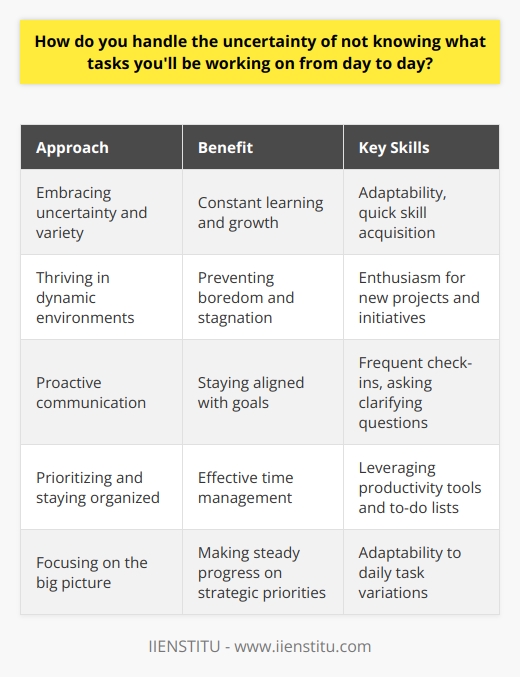
What strategies do you use to maintain a positive attitude when faced with unexpected challenges?
When faced with unexpected challenges, I maintain a positive attitude by focusing on solutions rather than dwelling on problems. I take a step back, assess the situation objectively, and break down the challenge into manageable parts. This helps me stay calm and centered, even under pressure.
Embracing a Growth Mindset
I view challenges as opportunities for growth and learning. When I worked as a project manager at my previous company, we encountered a major setback that threatened to derail our timeline. Instead of getting discouraged, I rallied the team together. We brainstormed creative solutions and ended up discovering a more efficient approach that not only got us back on track but also improved our overall process.
Practicing Gratitude and Optimism
I find that practicing gratitude helps me maintain a positive outlook, even in tough times. I start each day by writing down three things I'm thankful for, which sets a positive tone. When challenges arise, I focus on what I can control and look for the silver lining. A few years ago, I lost my job unexpectedly. While it was a difficult experience, I chose to view it as a chance to reassess my career path. That positive attitude led me to discover my true passion and pursue a more fulfilling direction.
Leaning on Support Systems
I've learned the importance of leaning on my support system during challenging times. Whether it's reaching out to a trusted mentor for guidance, talking through my concerns with friends or family, or collaborating with colleagues to find solutions - I know I don't have to face challenges alone. Their encouragement and fresh perspectives help me stay optimistic and resilient.
At the end of the day, I believe that maintaining a positive attitude comes down to a choice. We can't always control what happens to us, but we can choose how we respond. By focusing on solutions, embracing challenges as opportunities, practicing gratitude, and leaning on others, I'm able to stay positive and motivated, even in the face of unexpected challenges.
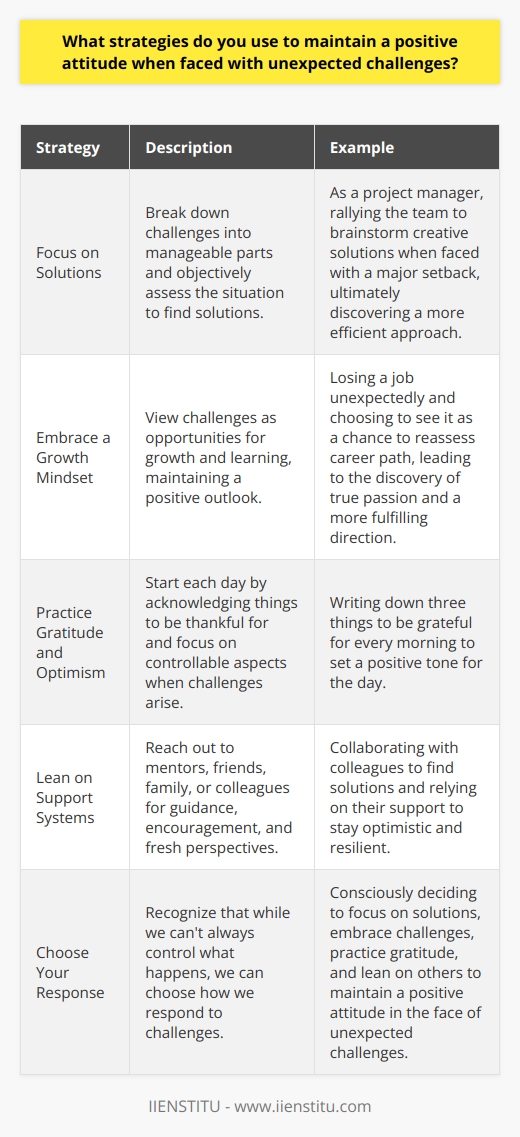
How do you ensure that you're continuously learning and growing when your role is flexible?
As someone who values continuous learning and growth, I make it a priority to seek out new opportunities, even when my role is flexible. I'm always looking for ways to expand my knowledge and skills, whether it's through formal training programs, attending industry conferences, or simply reading up on the latest trends and best practices in my field.
Setting Personal Learning Goals
One strategy I use is to set personal learning goals for myself. At the beginning of each quarter, I reflect on areas where I want to improve or new skills I want to acquire. Then, I create a plan with specific action items and deadlines to hold myself accountable.
Collaborating with Colleagues
Another way I ensure continuous learning is by collaborating with colleagues from different departments. I find that working on cross-functional projects exposes me to new perspectives and approaches. It also allows me to learn from experts in other fields and broaden my understanding of the business as a whole.
Embracing Stretch Assignments
When my manager offers me a stretch assignment or a project outside my comfort zone, I jump at the opportunity. While it can be challenging, I know that tackling new problems is one of the best ways to grow professionally. I'm not afraid to ask for help when I need it, and I view every obstacle as a chance to learn something new.
Seeking Feedback and Mentorship
Finally, I believe that feedback and mentorship are essential for growth. I regularly seek out input from my manager and peers on how I can improve. I also try to find mentors within the company who can offer guidance and support as I navigate my career. By staying open to feedback and actively seeking out new perspectives, I can continue to learn and grow, no matter how my role evolves over time.
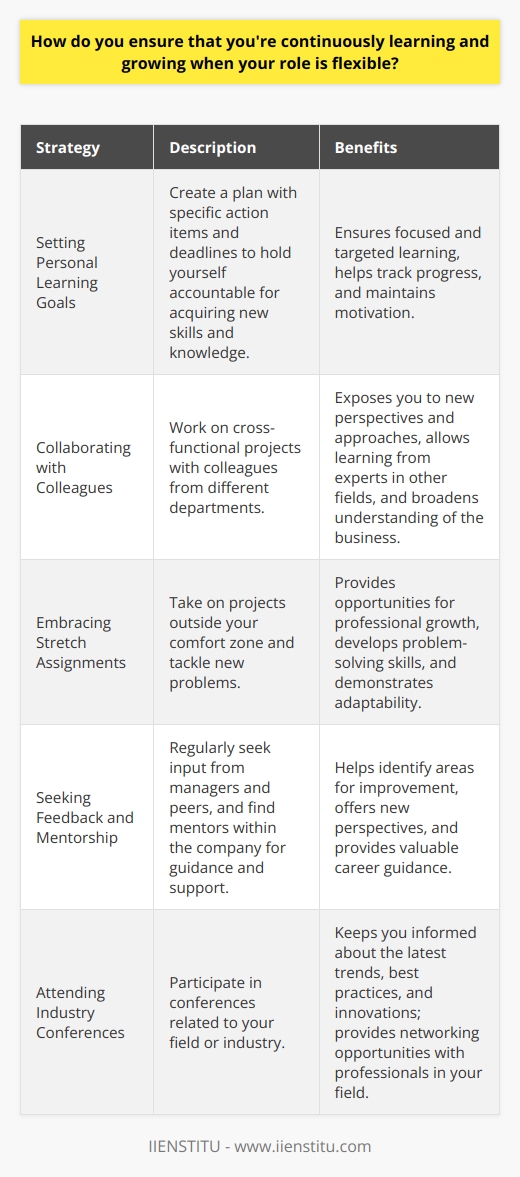
Describe a situation where you had to take on additional responsibilities unexpectedly.
In my previous role as a marketing coordinator, I unexpectedly had to take on additional responsibilities. Our team was working on a major product launch, and our project manager suddenly fell ill.
Stepping Up to the Challenge
Despite feeling overwhelmed, I knew I had to step up and fill the leadership void. I quickly assessed the situation and prioritized tasks to keep the project on track.
Collaborating with the Team
I worked closely with the team, delegating tasks based on each member's strengths. We held daily stand-up meetings to ensure everyone was on the same page and address any challenges.
Going Above and Beyond
I put in extra hours to review progress, provide feedback, and maintain open communication with stakeholders. It was challenging, but I remained focused on the end goal.
Successful Product Launch
Thanks to the team's hard work and my leadership, we successfully launched the product on time. The experience taught me the importance of adaptability, communication, and teamwork in the face of unexpected challenges.
Taking on additional responsibilities unexpectedly can be daunting, but it's also an opportunity for growth. By staying calm, prioritizing tasks, and collaborating with others, you can rise to the occasion and achieve great results.
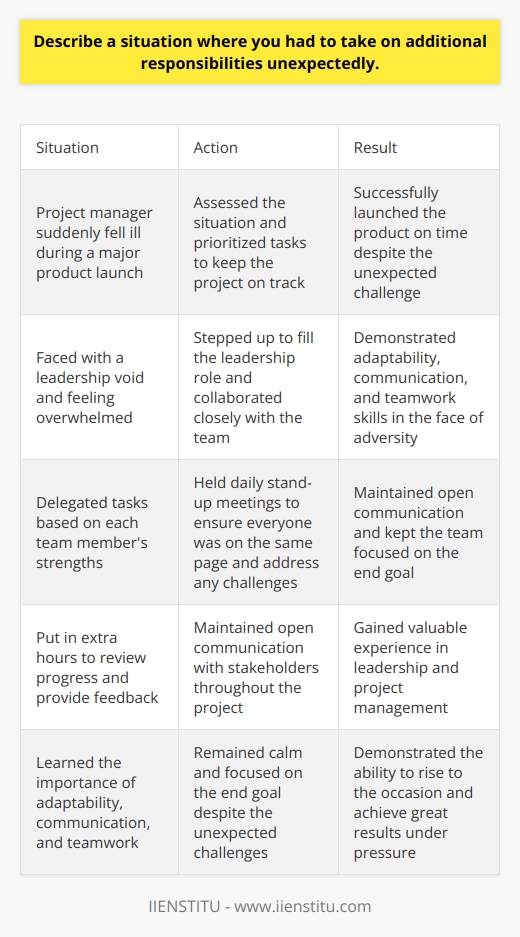
How do you maintain strong relationships with colleagues when your schedules are constantly changing?
I maintain strong relationships with colleagues by prioritizing open communication and flexibility. I make an effort to regularly touch base with my team members, even if our schedules don't align perfectly. This helps us stay connected and on the same page.
Adapting to Change
When schedules are constantly shifting, I believe it's important to be adaptable. I try to approach changes with a positive attitude and a willingness to adjust my own plans as needed. By being flexible, I show my colleagues that I value our working relationship and am committed to our shared goals.
Finding Creative Solutions
If conflicting schedules make it difficult to collaborate in person, I suggest alternative ways to connect. This might include a quick phone call, a virtual meeting, or even just a detailed email update. The key is to keep the lines of communication open and find solutions that work for everyone involved.
Showing Appreciation
I also make a point to express my appreciation for my colleagues' efforts, especially when our schedules are hectic. A simple "thank you" or acknowledgment of their hard work can go a long way in maintaining strong relationships. It reminds us that we're all in this together, even when we're not able to work side by side.
At the end of the day, I believe that building and maintaining strong relationships with colleagues comes down to communication, flexibility, and mutual respect. By prioritizing these things, I've been able to forge lasting connections with my team members, no matter how much our schedules may change.

What techniques do you use to quickly get up to speed on new projects or tasks?
When starting a new project or task, I dive right in and immerse myself in the available information. I quickly scan through documentation, project plans, and any relevant materials to grasp the big picture. This helps me understand the project's scope, objectives, and key stakeholders.
Asking Questions and Seeking Clarification
I'm not afraid to ask questions when something is unclear. I reach out to team members, managers, or subject matter experts to gain insights and fill in any knowledge gaps. Asking targeted questions helps me clarify expectations, understand priorities, and learn from others' experiences.
Breaking Down Tasks into Manageable Chunks
To avoid feeling overwhelmed, I break down large projects into smaller, manageable tasks. I create a roadmap or checklist to keep myself organized and focused. By tackling one task at a time, I can make steady progress and build momentum.
Leveraging Past Experiences and Transferable Skills
I draw upon my past experiences and transferable skills to adapt quickly to new situations. Even if the project is unfamiliar, I look for similarities or common principles that I can apply. This helps me hit the ground running and contribute value from day one.
Collaborating and Learning from Others
I believe in the power of collaboration. I actively engage with my team members, asking for their insights and guidance. I'm open to learning from their expertise and incorporating their feedback into my work. Collaborating closely with others accelerates my learning curve and ensures I'm aligned with the team's goals.
By combining these techniques – immersing myself in information, asking questions, breaking down tasks, leveraging past experiences, and collaborating with others – I can quickly get up to speed on new projects and start delivering results.
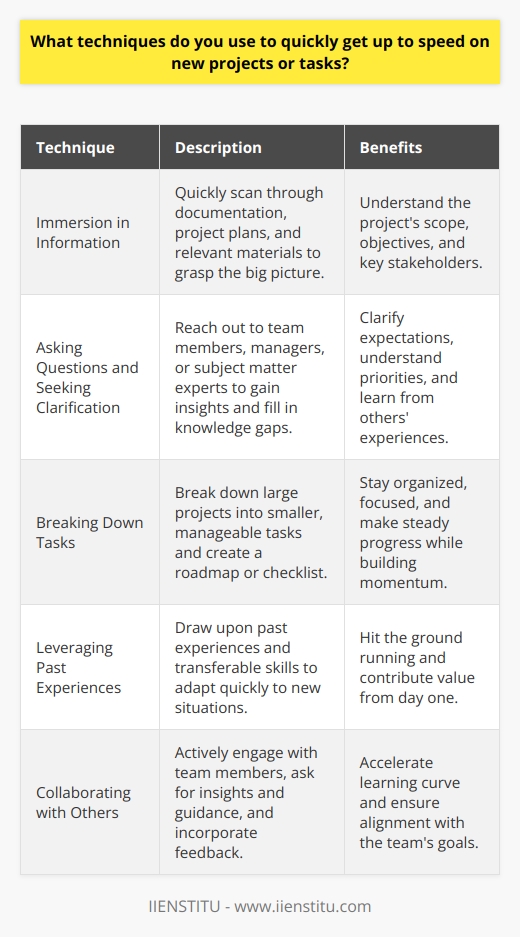
How do you ensure that you're meeting the expectations of your role when your workload is variable?
As someone who thrives in a dynamic work environment, I have developed several strategies to ensure that I consistently meet the expectations of my role, even when my workload is variable.
Communicate Regularly with My Manager
I believe that open and frequent communication with my manager is key to staying aligned with the expectations of my role. I make it a point to check in with my manager on a regular basis to discuss my current workload, prioritize tasks, and ensure that I am focusing my efforts on the most important projects.
Example:
In my previous role as a marketing coordinator, I faced a period where my workload suddenly increased due to a new product launch. I immediately scheduled a meeting with my manager to discuss the new projects on my plate and to ensure that we were on the same page about priorities. This proactive communication allowed me to adjust my focus and deliver on the most critical tasks, while also keeping my manager informed about my progress.
Set Clear Goals and Deadlines
Another strategy I use to meet the expectations of my role is to set clear goals and deadlines for myself. When my workload is variable, it can be easy to get overwhelmed or lose sight of what needs to be accomplished. By breaking down my tasks into specific, measurable goals with realistic deadlines, I am able to stay organized and focused on delivering results.
Example:
In my current role as a project manager, I often juggle multiple projects with varying timelines. To ensure that I am meeting the expectations of my role, I create detailed project plans with specific milestones and deadlines. I review these plans regularly and adjust them as needed based on changes in my workload or new information from stakeholders. This approach helps me stay on track and deliver projects on time, even when my workload is unpredictable.
Be Proactive About Seeking Feedback
Finally, I believe that seeking feedback is an essential part of meeting the expectations of my role. When my workload is variable, it can be challenging to know if I am focusing on the right tasks or delivering work that meets the needs of my team and organization. By proactively seeking feedback from my manager, colleagues, and stakeholders, I am able to gain valuable insights into areas where I can improve and ensure that I am meeting the expectations of my role.
Example:
In a previous role as a sales representative, I was responsible for managing a portfolio of clients with varying needs and expectations. To ensure that I was meeting the expectations of my role, I made it a habit to regularly seek feedback from my clients about their satisfaction with my work and any areas where I could improve. This feedback allowed me to adjust my approach and deliver better results, even as my workload changed from week to week.
In summary, by communicating regularly with my manager, setting clear goals and deadlines, and proactively seeking feedback, I am able to ensure that I am consistently meeting the expectations of my role, even when my workload is variable. These strategies have served me well in my career so far, and I am confident that they will continue to help me succeed in any role I take on.
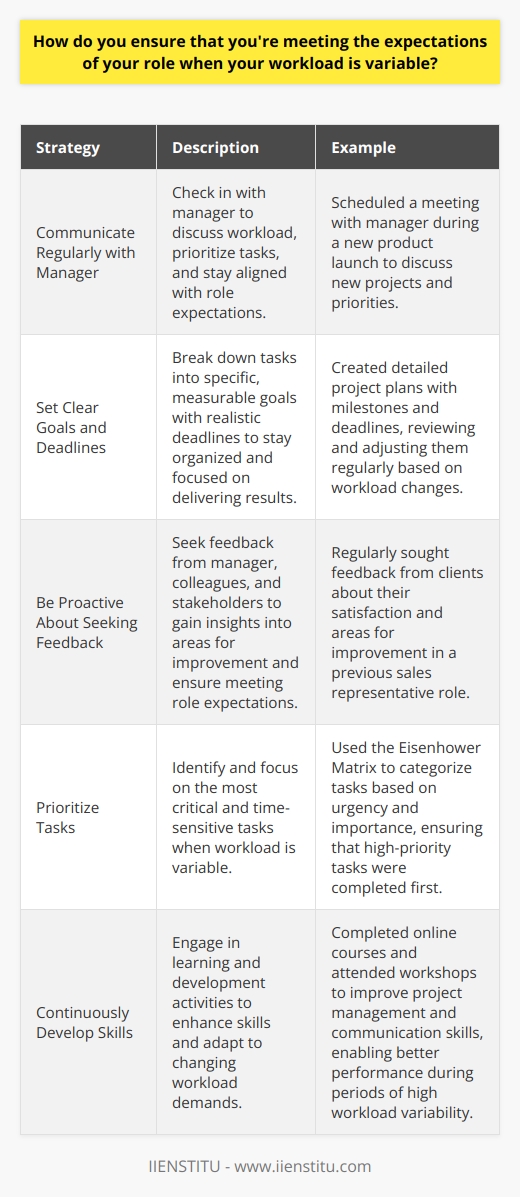
Describe a time when you had to adapt to working with a new team or client.
I once had to adapt to working with a new client who had very different expectations and communication styles than what I was used to. At first, it was challenging to understand their needs and preferences, but I quickly realized that the key to success was to be flexible and open-minded.
Listening and Asking Questions
I made a conscious effort to listen carefully to the client's feedback and ask clarifying questions when needed. This helped me gain a better understanding of their perspective and what they were looking for in the project.
Adjusting My Approach
Based on the insights I gained from listening and asking questions, I adjusted my approach to better align with the client's expectations. This involved adapting my communication style, the way I presented ideas, and the level of detail I provided in my work.
Collaborating with the Team
I also worked closely with my team members to ensure that we were all on the same page and delivering a cohesive solution to the client. We had regular check-ins to discuss progress, share ideas, and address any challenges that arose.
Positive Outcome
In the end, by being adaptable and proactive in my approach, I was able to build a strong working relationship with the new client and deliver a successful project that met their needs. This experience taught me the importance of being flexible and open to new ways of working, especially when collaborating with diverse teams and clients.
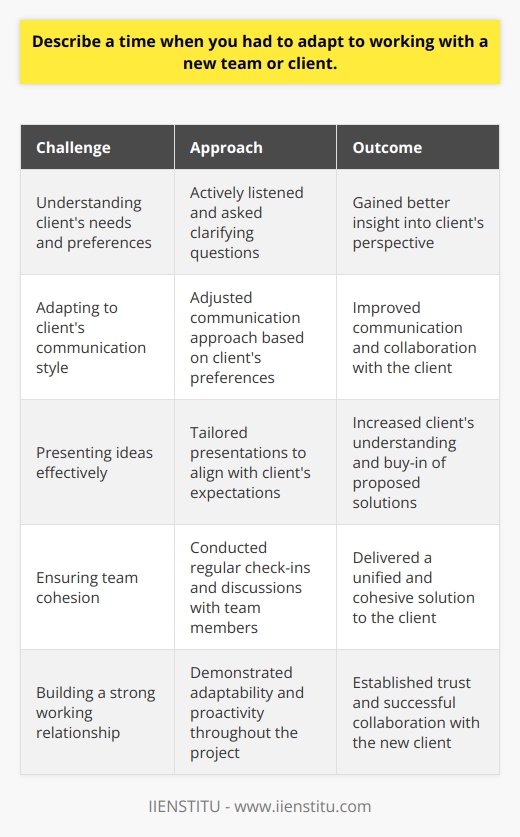
How do you maintain a sense of structure and routine when your work schedule is flexible?
Maintaining a sense of structure and routine with a flexible work schedule is all about personal discipline and organization. Here are some strategies I've found effective:
Set Consistent Work Hours
Even though my schedule is flexible, I still designate specific hours each day for focused work. This helps me stay productive and avoid procrastination. I treat these hours like any other workday, minimizing distractions and aiming to accomplish my key tasks.
Create a Daily To-Do List
Every morning, I make a to-do list of the most important things I need to get done. Checking items off as I go gives me a sense of progress. If something doesn't get finished, I add it to the next day's list. The satisfaction of completing my list motivates me to stay on track.
Take Regular Breaks
Paradoxically, taking breaks actually helps me maintain my focus and structure. I step away from my desk every couple hours to stretch, grab a snack, or take a quick walk outside. These small breaks re-energize me and improve my concentration when I dive back into work.
Communicate with My Team
Even when working flexibly, I make a point to regularly check in with my colleagues and manager. Sending updates, asking questions, and offering help keeps me engaged with my team's goals and deliverables. Knowing what everyone else is working on adds purpose and structure to my individual tasks.
Ultimately, thriving with a flexible schedule comes down to holding myself accountable and proactively managing my time. By setting my own routines and consistently following them, I'm able to enjoy the freedom of flexibility while still achieving my professional goals.
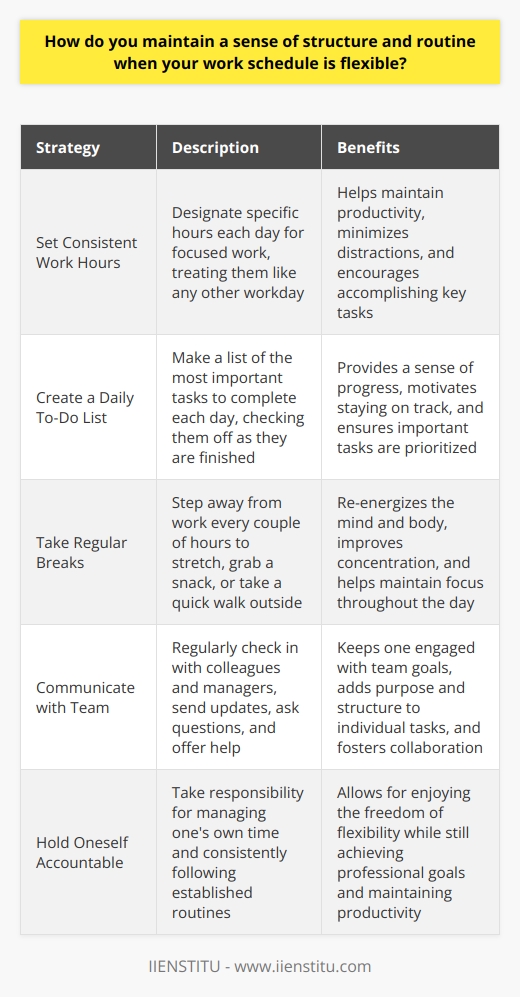
What strategies do you use to anticipate and prepare for potential changes in your workload?
I anticipate potential changes in my workload by regularly communicating with my team and manager. This helps me stay informed about upcoming projects and deadlines, so I can adjust my priorities accordingly. I also make a habit of keeping my skills up-to-date through continuous learning and development.
Staying Organized is Key
To prepare for fluctuations in my workload, I maintain a well-organized task list and calendar. I break down larger projects into smaller, manageable tasks and set realistic deadlines for each one. This allows me to easily shift gears if unexpected work comes up without getting overwhelmed.
Prioritizing and Delegating
When my workload increases, I prioritize tasks based on their importance and urgency. I focus on the most critical tasks first and delegate or reschedule less pressing items. I'm not afraid to ask for help when needed – collaborating with colleagues can make a big difference in managing a heavy workload.
Maintaining Flexibility
I've learned that flexibility is essential in today's fast-paced work environment. I try to maintain a positive attitude and adapt quickly to changes in my workload. If a project gets delayed or a new priority emerges, I regroup and refocus my efforts without getting stressed out.
By staying organized, prioritizing effectively, and remaining flexible, I'm able to anticipate and prepare for potential changes in my workload. These strategies have served me well in my career, allowing me to consistently meet deadlines and deliver high-quality work, even during busy periods.
